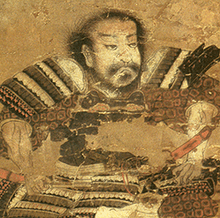Shibata Katsuie
| Shibata Katsuie 柴田 勝家 | |
|---|---|
 Shibata Katsuie | |
| Born |
1522 Owari Province |
| Died |
June 14, 1583 (aged 60–61) Battle of Shizugatake, Echizen Province |
| Allegiance |
|
| Unit | Shibata clan |
| Battles/wars |
Battle of Okehazama Battle of Anegawa Siege of Odani Castle Battle of Nagashino Battle of Tedorigawa Battle of Shizugatake |
| Spouse(s) | Oichi |
Shibata Katsuie (柴田 勝家, 1522 – June 14, 1583) or Gonroku (権六) was a Japanese samurai and military commander during the Sengoku period.
He served Oda Nobunaga as one of his trusted generals, was severely wounded in the 1571 Siege of Nagashima, but then fought in the 1577 Battle of Tedorigawa.[1]
Biography
Katsuie was born in the village of Kamiyashiro (present-day Meitō-ku, Nagoya), a branch of the Shiba clan (who descended from the Ashikaga clan, and were the former suzerains of the Oda clan). Note the differences between Shibata (柴田), Shiba (斯波), and the Shibata clan of Echigo (新発田).
Katsuie was the retainer of Oda Nobukatsu (Oda Nobuyuki). When control of the Oda clan was contested, Katsuie initially supported his lord, Nobukatsu, against his elder brother Oda Nobunaga. In 1556, Katsuie launched a coup d'état against Nobunaga. He was defeated at the Battle of Inō, and in the aftermath Nobunaga had his brother executed, but impressed with the retainer's loyalty and bravery, spared the life of Katsuie. Katsuie pledged his services to Nobunaga, earning his praises.
In 1570, while a joint Oda–Tokugawa coalition fought the Battle of Anegawa, Katsuie was under Siege of Chōkō-ji Castle by 4000 soldiers of the Rokkaku clan. Katsuie eventually won via an all-out attack, forcing the Rokkaku to retreat.[1]:220 This action, along with a series of brilliant victories, gained him renown as "Oni Shibata".
He fought in the Battle of Nagashino.[2]
In 1575, after gaining control of Echizen, he took command of Kitanosho Castle (Hokujō) and was ordered to conquer the Hokuriku region.
In 1580, he led an army, which included his general Sakuma Morimasa in a fight against the Kaga Ikko-ikki at Kanazawa Gobo.[1]:230 After controlling Noto, he began a campaign against Etchū Province in 1581.
In 1582, he and Sasa Narimasa successfully laid siege to Uzu and Matsukura Castle.[1]:231
In 1582, Nobunaga was betrayed at Honnō-ji by Akechi Mitsuhide. In a meeting in Kiyosu to determine the successor to Nobunaga, Katsuie initially supported the choice of Samboshi. He then supported Oda Nobutaka, the third son, for whom Katsuie had performed the genpuku ritual, and allied with Oda Nobutaka and Takigawa Kazumasu to battle Hideyoshi. Katsuie sent his nephew Sakuma Morimasa to besiege Nakagawa Kiyohide at Shizugatake in the battle of Shizugatake. Sakuma ignored Shibata's orders to withdraw to Ōiwa, and were attacked Toyotomi Hideyoshi's returning forces. They retreated back into Echizen all the way to Kitanoshō castle, which was taken 3 days later. Katsuie committed seppuku, after killing his wife, Oichi and other members of his household, and set fire to the castle. He implored Oichi to take their daughters and leave, but she decided to follow his death, while letting her daughters escape.[3][4][1]:234
His death poem was:
- 夏の夜の 夢路儚き 後の名を 雲井にあげよ 山不如
- Natsu no yo no
- yumeji hakanaki
- ato no na o
- kumoi ni ageyo
- yamahototogisu
- "Fleeting dream paths, in the summer night! O bird of the mountain, carry my name beyond the clouds."
Family
- Wife: Oichi
- Step-daughters:
- Adopted sons:
- Shibata Katsutoyo
- Shibata Katsumasa
In popular culture
Shibata Katsuie is a playable character in Koei Tecmo's Samurai Warriors 2: Empires and all subsequent Samurai Warriors and Warriors Orochi games. He fights with a normal spear in Empires and twin axes in later games.
He is also a playable character in the game Sengoku Basara 4 for the PlayStation 3. He wears green armor and uses a dual-sided spear.
See also
References
- 1 2 3 4 5 Turnbull, Stephen (2000). The Samurai Sourcebook. London: Cassell & C0. p. 78,221,228. ISBN 1854095234.
- ↑ Turnbull, Stephen (1977). The Samurai. New York: Macmillan Publishing Co., Inc. pp. 156–160. ISBN 9780026205405.
- ↑ "Fukui Castle, Kitanosho Ruins". 2009-03-24. Archived from the original on 11 December 2008. Retrieved 30 April 2009.
- ↑ Sansom, George (1961). A History of Japan, 1334-1615. Stanford: Stanford University Press. p. 311-313. ISBN 0804705259.
External links
| Wikimedia Commons has media related to Shibata Katsuie. |
This article incorporates text from OpenHistory.